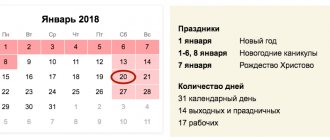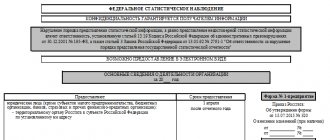The average headcount indicator (hereinafter also referred to as SCH) is needed by the tax authorities, as well as for inclusion in various reporting forms. What are the methods and nuances of calculating this indicator? Find out from the article with examples of calculating the average headcount 2020 for different situations.
Also see:
- Individual entrepreneurs without employees: is it necessary to submit the average number of employees?
- Information on the average number of employees: form 2020
Payroll and average number
The SSC indicator is closely related to the headcount indicator. To understand how to calculate the average payroll, let’s figure out who is on the payroll.
The payroll (or payroll) takes into account everyone with whom employment contracts have been concluded at their main place of work.
IMPORTANT!
If the founder of the organization works under an employment contract, he is also included in the payroll.
IMPORTANT!
For inclusion in the payroll, the duration of the employment contract does not matter. Even if the employee worked only 1 day, he must be taken into account when calculating the indicator.
To determine the payroll number, such an important document as a working time sheet . In order to have correct data, a time sheet must be kept every day , noting in it those who came to work and those who for some reason did not show up.
In addition, for each person who appears at work, the amount of time (hours) worked should be noted on the timesheet.
Based on the notes on the payroll in the time sheet, you can then determine the average number of employees for a period of time.
What is the difference between payroll and regular numbers?
The law does not contain such a thing as “staffing”. However, this term is used in practice. It denotes the number of workers specified in the staffing table of the enterprise. That is, this is the number of occupied and vacant positions.
The headcount is the number of employees with whom the employer has entered into employment agreements. In this case, the duration of the contract or actual presence at the workplace are not important.
Staffing is a broader concept. The manager has the right to set staffing levels in accordance with his needs and wishes. In this case, you need to be guided by the expected level of productivity and scale of production.
Calculation of the average headcount using the Rosstat methodology
The basic methodology for calculating the SCN was established by Rosstat - the Instructions were approved by order No. 711 dated November 27, 2019.
Let us note that previously the accountant may have encountered other rules for calculating the SCH. This was due to the fact that extra-budgetary funds (PFR and Social Insurance Fund) offered their instructions for calculating the indicator indicated in the reports for them.
For example, the Law “On Insurance Contributions” No. 212-FZ (repealed) included the phrase “the average number of individuals in whose favor payments and other remunerations are made.” Thus, all individuals receiving remuneration from the policyholder were included in the calculation of the SCH for the funds. Including those who do not need to be taken into account according to the Rosstat methodology (for example, external part-time workers and those working under GPC agreements).
By 2021, laws and other regulations with such wording have lost force . All laws and instructions for calculating the SCN for different departments now refer to the Instructions of the authorized statistics body. That is, Rosstat.
Let's consider the rules for calculating the average headcount according to the current Rosstat Instructions.
Providing information on the average number of employees
A report on the average number of personnel is necessary to comply with legal requirements when filling out the following declaration forms:
- Calculation of accrued and paid insurance contributions for compulsory social insurance (Form 4-FSS);
- Calculation of accrued and paid insurance contributions for compulsory pension insurance (form RSV-1 PFR);
- Information on the average number of employees for the previous calendar year (KND form 1110018);
- Information on the number, wages and movement of workers (form P-4);
- Information on the main performance indicators of a small enterprise (Form N PM);
The average number of employees depends on:
- Possibility of obtaining tax benefits if an enterprise uses the work of disabled people (VAT, income tax, property tax and land tax);
- And the need to send declarations for the previous year to the tax service in the form of an electronic document if the number of employees of the enterprise is higher than one hundred people. (Article eighty of the Tax Code of the Russian Federation);
Information on the average number of employees must be prepared by the company regardless of whether the company has employees or whether the company is actively operating. If there are no personnel on the company’s staff, the number zero must be entered in the corresponding field of the reporting form. The average headcount is calculated both for a long-running enterprise, and for a newly created one (before the twentieth day of the month that follows the month the company was founded) and for a closing enterprise (information should be prepared not for the month, but for the specific date of liquidation of the company).
Calculation of the average value for a full month
The formula for calculating the average headcount for a month, given in the Rosstat Instructions, is as follows:
The number of employees on a weekend or holiday is recognized as the same as on the working day the day before.
IMPORTANT!
2 categories of employees are taken into account in the payroll, but are not included in the SSC. This:
- employees on maternity and child care leave;
- employees who took additional unpaid leave to enroll in educational institutions.
EXAMPLE
As of December 31, the payroll numbered 20 people. The New Year holidays lasted from January 1 to January 10. Since the 11th, 3 new employees started working. Since January 20, one employee went on maternity leave. What is the average headcount for January?
- from January 1 to January 10 (10 days) – payroll 20 people;
- from January 11 to January 19 (9 days) – 23 people;
- from January 20 to January 31 (11 days) – 22 people (on payroll 23 people, but to calculate the MHC we exclude the employee on maternity leave).
TSS for January = (10 (days) × 20 (persons) + 9 × 23 + 11 × 22)/31 = (200 + 207 + 242)/31 = 20.93 = 21 ( rounded to whole units).
Calculation of the average monthly value for less than a month
Such a calculation is needed much less frequently. For example, if the organization has just been registered or has closed.
Calculating the average headcount for an incomplete month has its own characteristics.
EXAMPLE
The LLC was registered on February 10, 2021 with 10 employees. Until the end of February, no changes in the payroll occurred. Let's calculate the MPV for February 2021:
MSS = (20 days (from February 10 to February 29) × 10)/29 = 6.89 = 7 (rounded).
TAV indicator for the reporting period
In practice, it is often necessary to determine and indicate in reports the average headcount indicator for a period longer than a month - a quarter, half a year, 9 months, a year.
The basis for calculations will still be the MSS for each month included in the period. Next, the average value is determined using mathematical rules:
EXAMPLE
The average headcount in the LLC was:
- January-March – 30;
- April-May – 32;
- June – 33.
LLC needs to calculate the MVC for the first half of the year.
TSS for half a year = (3 (months) × 30 (TSS) + 2 × 32 + 1 × 33) / 6 (months in the period) = 31.17 = 31.
Providing information on the average number of employees
Individual entrepreneurs provide data on the average number of employees at the place of registration. LLCs submit information at the location of their office. There are three ways to provide information - in person to the Federal Tax Service, by mail or electronically via telecommunication channels.
The deadline for submitting a certificate of average number of employees is until the twentieth of January. For newly established enterprises - until the twentieth day of the month following the date of establishment of the company.
The fine for failure to submit a certificate of average number of employees is 200 rubles.
How to calculate the average value for an incomplete period
The indicator for a period in which not all months included in it have been worked out is calculated by analogy with an incomplete month. It is necessary to add up the MSS in the same way for each month in which there were employees and divide by the total number of months included in the period.
EXAMPLE
The agricultural enterprise operates 6 months a year, for which it hires workers.
The average value for working months was:
- from April to June – 50 people;
- in July and August – 60 people;
- in September – 40 people.
It is necessary to calculate the MPV for the year.
TSS for less than a year = (3 × 50 + 2 × 60 + 40) / 12 = 25,83 = 26.
Inclusion of part-time employees in the SSC
The above formulas are designed for cases where all employees work full time (day or week). If the enterprise also has those who are employed part-time, then when including them in the SSC there are nuances.
Those working part-time must be counted in proportion to actual work hours. additional calculations must be made for part-time employees :
EXAMPLE
In a company, one employee works 4 hours a day, the second - 3 hours.
In June (21 working days) they worked together:
- (4 hours × 21 days) + (3 hours × 21 days)) = 147 hours.
Number of man-days with a 40-hour week for them in June:
- 147/8 = 18.37 man-days.
TSS for part-time workers = 18.37 / 21 = 0.875 = 1 (rounded).
IMPORTANT!
Employees who are transferred to part-time work on the initiative of the administration without obtaining written consent from them are counted as whole units.
Formula for calculating the average number of employees per month
The calculation of the average number of employees differs for full-time workers and for the following categories of workers: part-time workers and external part-time workers, workers under civil-sector agreements.
The category of part-time workers does not include workers with reduced working hours (disabled people, workers under the age of eighteen, and other categories). These workers are counted in the average payroll according to the rules for full-time workers, that is, as entire staff units.
The average number of full-time employees per month is equal to the amount on the payroll for each day of the month divided by the number of calendar days of the month. It is important that the payroll must be determined for each day of the month, regardless of whether it is a working day or a non-working holiday. The resulting amount is also divided by the total number of calendar days of the month.
How to calculate the payroll number on a non-working or weekend day? The payroll number for the weekend is equal to the payroll number for the previous working day. If there are several days off in a row, the payroll number of each of them is equal to the last previous working day.
In order to calculate the average number of part-time workers , external part-time workers and workers under civil and personal agreements, it is necessary to recalculate to full-time employment. First of all, this requires determining the number of man-days they worked.
The number of man-days worked is equal to the sum of man-hours worked divided by the working day established for a specific employee. In other words, for workers with different working hours, the calculation must be carried out separately. The main options for part-time working hours:
- With a 36-hour five-day period – 7.2 hours;
- With a 36-hour six-day period - 6 hours;
- With a 24-hour five-day period - 4.7 hours;
- With a 24-hour six-day period - 4 hours;
Moreover, if an employee was sick on a working day, was on vacation or skipped work, these days are included in the calculation of man-hours worked based on the number of hours worked on the previous working day.
After calculating the total number of man-days worked, it is necessary to calculate the average number of employees in terms of full-time employment. To do this, the total number of person-days worked is divided by the number of working days in the month.
Formula for calculating the average number of part-time workers:
There is another, perhaps simpler, method for calculating the average number of part-time workers. To do this, you need to divide the duration of part-time work by normal (8 hours). For example, if an employee works 4.7 hours a day, but he is counted for each working day as 0.5875 staff units. Then the resulting value must be multiplied by the number of days worked by the employee per month. Next, the sum of the obtained values for all part-time workers is calculated, and this sum is divided by the number of working days according to the calendar.
In the final calculation of the average headcount for the enterprise as a whole, the total values for all categories of employees are summed up and rounded to a whole number according to the general rounding rules: if the number after the decimal point is 5 or more, then the number is rounded up.
Calculation of the SCH, if there are full-time and part-time employees
Separately, we should dwell on how to calculate the average payroll for a period if the organization employs employees with different working hours - full-time and part-time.
In this case, to determine the SCH for the period, you need to separately calculate the monthly SCH indicators for full-time and part-time employees. Then add up all the obtained values for the period and divide by the number of months in the period.
EXAMPLE
Let the company from the previous example employ, in addition to part-time employees, 19 more full-time employees. Over the year, the picture with personnel did not change: 12 months, the average number of employees with full time was 19, with part-time work – 1.
TSS for the year for all = (19 × 12 + 1 × 12) / 12 = 20.







